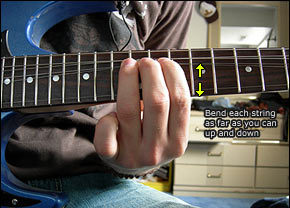Stretching Strings(for new strings)
Have you ever noticed that when you put on new strings on your guitar it seems to go out of tune a lot for the first couple of days? It happens, the new strings aren't used to being stretched tightly so they are getting used to being stretched. You have to break them in. To help speed up the process there is something you can do. You can stretch them out.
Steps to Stretch or break in your strings.

- First - you need to have your new strings strung on your guitar and in tune
- (doesn't have to be exact because it is going to get out of tune real fast but just tune it close to where the tone should be.)
- Second - Find the 12th fret on your guitar, this is the middle of the string. We are going to bend the string here so you get maximum bendage. See picture at the right if you don't know what bending is.
- Third - at the 12th fret, on the first string, bend the string as far as you can without breaking it. Hold it down for a couple of seconds and you can pluck the string a couple of times if you want. Then just keep bending it up and down as far as you can to stretch it.
- Do this with each string.
You will notice that after you do this with each string, if you check the tuning now, it is probably jacked, out of tune. Quickly tune each string, and then repeat the process of bending each string until your tuning stops changing after you bend them. That is all to it.
Reference Note Volume
This is a quick tip. When tuning your guitars, when you tune using another note as a reference, for example our online guitar tuner produces a note that you tune your guitar tune to, you have to make sure that the sound that the tuner produces and the sound that your guitar produces, should be equal volume. You should adjust the volume on your computer until it has as much volume as your guitar. Doing this will help it so the sound coming from your computer doesn't drown out or overpower the sound that your guitar produces, or vice versa. This will help you tune with greater accuracy.
Tune from being Flat, up
ALWAYS TUNE UP TO THE NOTE. ALWAYS. When you tune down, some invisible slack will often remain above the 'nut' (the '0' fret), and with a few strums, the slack works its way over the nut to the rest of the string. When you tune, go "down or flat" below the note, and then tune up. If you over-tighten and make the pitch too high, go below the note again and make another attempt. This is the first rule I learned from my guitar teacher in High School. It really makes a difference, and it applies equally to other instruments. With small instruments such as the Ukulele, it is even more key that you do this because of the short neck is has. That small amount of slack is enough to change the pitch of a string noticeably.
When tuning, make several passes.
Make several passes tuning each of the strings. For example you might have noticed that if you have tuned all the strings once, and then back to the first one you tuned, it might be off a little bit. This is because you are increasing or decreasing the tension on each of the strings as you tune it and the instruments body might bend ever so slightly due to this difference in tension. This causes the other strings to slightly change in pitch. So make sure you keep on checking and tuning the strings until all are in tune, so make several passes.



